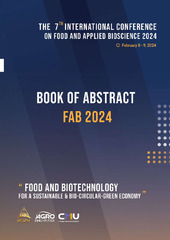Приказ основних података о документу
Breadmaking potential of sourdoughs made with wholegrain flour derived from old wheat landraces and varieties
| dc.creator | Tomić, Jelena | |
| dc.creator | Hadnađev, Miroslav | |
| dc.creator | Mandić, Anamarija | |
| dc.creator | Mišan, Aleksandra | |
| dc.creator | Pojić, Milica | |
| dc.creator | Dapčević-Hadnađev, Tamara | |
| dc.creator | Mikić, Sanja | |
| dc.date.accessioned | 2024-02-29T13:29:36Z | |
| dc.date.available | 2024-02-29T13:29:36Z | |
| dc.date.issued | 2024 | |
| dc.identifier.uri | http://fiver.ifvcns.rs/handle/123456789/4311 | |
| dc.description.abstract | Wheat breeding efforts, which have been focused narrowly on crop yield increases, have caused a reduction in genetic diversity. Namely, old wheat landraces have been unfairly neglected and reduced to small quantities in gene banks and, at lesser extent, in farm private collections for a long time. However, the local landraces and the traditional old varieties of wheat have gained new attention, presumably owing to the increased public awareness of the need to preserve genetic diversity and the increased consumers’ demand for genuine and traditional foods. The aim of this study was to evaluate the rheological properties of wholegrain flour from three different wheat species (7riticum aestivum subsp. aestivum, black grain bread wheat variety; Triticum turgidum subsp. durum, durum wheat; and Triticum aestivum subsp. spelta, spelt wheat) and to test their suitability to produce spontaneously fermented sourdough as an adequate leavening agent in wheat bread production. Spontaneous fermentation of flours was carried out for 5 days with back-slopping every 24 h (dough yield of 200) at 25°C. After achieving mature sourdough, the bread was prepared by replacing refined wheat flour at a 20% level with sourdough samples. Bread with the addition of sourdough made of modern wheat varicties and bakery yeast-fermented bread were used as controls. The technological properties of the wholegrain flours estimated by means of Mixolab indicated rather good protein quality and the ability to form doughs with good stability in all tested samples. The black grain wheat variety showed significantly longer dough development times and higher mixing and dough stability, while the GlutoPeak parameters obtained for this variety were comparable to those of modern wheat. The addition of sourdough from old wheat landraces resulted in breads of similar specific volume and texture. Regarding the sensory evaluation, the most prominent differences were obtained for the textural, odour, and flavour properties. Breads with the addition of old wheat sourdough stood out from the control samples in terms of yeast and vinegar odour and flavour notes. The results reported herein showed that the technological performance of old wheat flour, especially when combined with sourdough processes, could be successfully exploited for the production of breads comparable to those of modern wheat varieties. | sr |
| dc.language.iso | en | sr |
| dc.publisher | Chiang Mai : Chiang Mai University, Faculty of Agro-Industry | sr |
| dc.relation | FAO project: Redesigning the exploitation of small grains genetic resources towards increased sustainability of grain-value chain and improved farmers’ livelihoods in Serbia and Bulgaria – GRAINEFIT; 2019-2022 | sr |
| dc.rights | openAccess | sr |
| dc.rights.uri | https://creativecommons.org/licenses/by/4.0/ | |
| dc.source | Book of Abstract, 7th International Conference on Food and Applied Bioscience (FAB 2024) "Food and Biotechnology for a Sustainable and Bio-Circular-Green Economy", 8-9 February 2024, Chiang Mai, Thailand | sr |
| dc.subject | Old wheat landraces | sr |
| dc.subject | wheat | sr |
| dc.subject | landrace | sr |
| dc.subject | sourdough | sr |
| dc.subject | rheology | sr |
| dc.subject | breadmaking | sr |
| dc.title | Breadmaking potential of sourdoughs made with wholegrain flour derived from old wheat landraces and varieties | sr |
| dc.type | conferenceObject | sr |
| dc.rights.license | BY | sr |
| dc.citation.spage | 78 | |
| dc.identifier.fulltext | http://fiver.ifvcns.rs/bitstream/id/11544/bitstream_11544.pdf | |
| dc.identifier.rcub | https://hdl.handle.net/21.15107/rcub_fiver_4311 | |
| dc.type.version | publishedVersion | sr |


